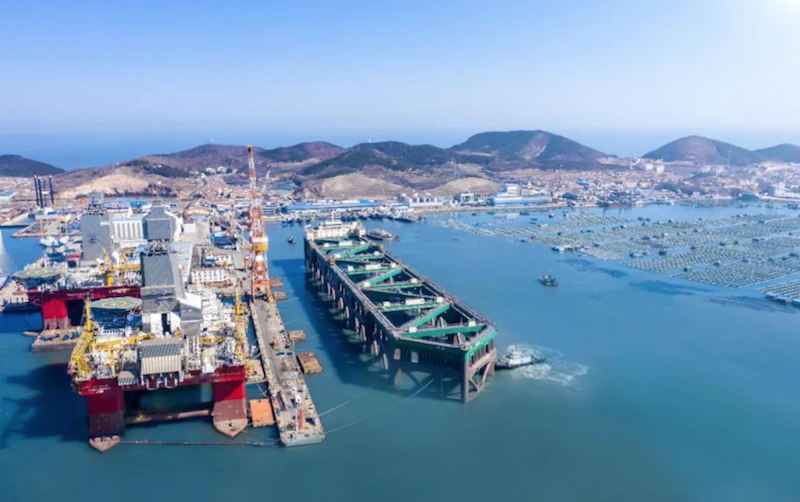
On March 31, 2020, CIMC Raffles held a naming and departure ceremony for HAVFARM 1, the world’s largest and most advanced deep-water aquaculture workboat built for Nordlaks Oppdrett AS. The workboat, named JOSTEIN ALBERT, will be transported in the form of “dry towing” in collaboration with CIMC Logistics to the Hadsel, Norway for deep and open sea salmon farming operations.
JOSTEIN ALBERT was jointly developed and designed by Nordlaks and NSK Ship Design, and CIMC Raffles was responsible for foundation design, detailed design and final assembly & construction. The workboat is 385 meters long and 59.5 meters wide, with a total area of about four standard football fields. It is composed of six intelligent deep-water cages, and the farming scale can reach 10,000 tons, or about 2 million salmons. This workboat is the world’s first farming equipment using a single point mooring system. In daily operation, the ship can rotate 360 degrees around the mooring system with the seawater flow to accelerate the seawater exchange and improve the farming environment. In severe weather, this special mooring system can greatly reduce the impact of waves and other factors on the hull, ensuring the safety of farming.
Meanwhile, in order to meet the needs of modern aquaculture, the workboat is equipped with the world’s most advanced automated salmon aquaculture system, which can achieve the functions of automatic fry delivery, automatic feeding, underwater lamp monitoring, underwater oxygen enrichment, dead fish recovery, and automatic adult fish hunting. In addition, this workboat meets the world’s most stringent NORSOK (Norwegian petroleum industry technical code) standards; it is classified by the DET NORSKE VERITAS and can adapt to the extreme cold weather and harsh sea conditions off the Norwegian Fjords. With its huge size, high configuration and strict standards, it can be called the “Giant” of fishery equipment.
In the construction process, for the first time a giant truss structure was used for the hull erection of the workboat, which required the docking of six closures at one time. Compared with the conventional single-closure docking, the difficulty in this docking increased greatly. The construction standard of steel structure is high, and the welding quantity of special-shaped structure is large. The amount of NDT alone is twice that of the ordinary semi-submersible platform. The paint of the workboat meets the highest current coating standard of "NORSOK M501", and the “perfect and rigorous” coating process has a designed life of 25 years.
“Norway’s advanced Marine engineering design capabilities and China’s high-end equipment construction capabilities led to the creation of JOSTEIN ALBERT. With the full cooperation of ship owner, design company, classification society and suppliers, we have achieved a number of technological breakthroughs and process improvements, which have enriched our experience and capability in the field of deep and open sea aquaculture cages,” CIMC Raffles’ Executive Vice President Tao Ni said.
As a leading contractor of Marine engineering equipment in China, CIMC Raffles has successfully developed a number of aquaculture cages suitable for different sea areas through independent innovation and the R&D interactions between China and Europe. JOSTEIN ALBERT is the first international order in deep and open sea aquaculture cage field for CIMC Raffles. It has overcome the difficulty of no precedent for reference and the challenges of strict design and construction standards, made breakthroughs in a number of core technologies such as the overall design and calculation of the netting, and filled the gap in related fields in China.
Nordlaks, one of Norway’s leading salmon farming enterprises, has moved from offshore salmon farming to deep and open sea salmon farming in response to the Norwegian government’s green fish farming policy. After being put into operation, JOSTEIN ALBERT will solve the problems of frequent outbreaks of fish diseases and insufficient space in Norwegian Fjords, make full use of ocean space, improve the environmental benefits of salmon farming, and provide a good demonstration effect for the widespread application of this type of farming equipment in Norway.
Source: CIMC

